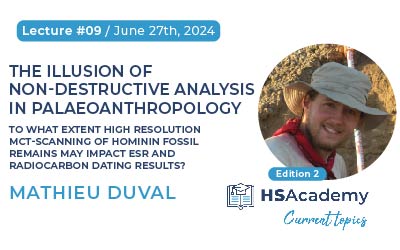
CTinHS Lecture 9 – 2023/24:
Mathieu Duval will deliver the 9th lecture of the 2nd edition of the “Current Topics in Heritage Science” on the topic: The illusion of non-destructive analysis in Palaeoanthropology. To what extent high resolution mCT-scanning of hominin fossil remains may impact ESR and Radiocarbon dating results? on Thursday, June 27th, at 3.00 pm (CEST).
Abstract
In palaeoanthropological research, the study of human fossils is conditioned by the necessity to cause minimum damage to these rare and valuable remains. In this context, micro-computerized tomography (µCT) scanning of fossils is nowadays routinely used to record a high resolution 3D reconstruction of samples, enabling to obtain critical information about the morphology or internal structure of the fossil, and create a digital archive of fossils that may be destructively analysed later. While these destructive analyses may be carried out for a wide range of purposes, including palaeodiet or palaeoenvironment reconstructions, mobility studies, ancient DNA and Geochronology, the potential impact of µCT scanning on the analytical results has been very little investigated so far. In the present lecture, we present the most recent results on our methodological investigations focused on Radiocarbon and Electron Spin Resonance (ESR) dating, which can both be directly applied to fossils. While Radiocarbon dating is the most widely used for any fossils younger than 50 ka, ESR can take over for older specimens. In particular, the latter has become very popular over the last couple of decades, with the dating of several key human fossils, such as those from Jebel Irhoud, (Morocco), Atapuerca Gran Dolina (Spain), Rising Star (South Africa) or Milsiya (Israel). It is therefore crucial to establish whether µCT scanning has a negative impact on the associated ESR and Radiocarbon analysis, and, if any, to determine how this impact can be reduced. With this purpose in mind, we carried out a series of tests with various conventional µCT instruments and using a range of acquisition parameters. The main experimental results will be presented and discussed in this talk, as well as their implications for palaeoanthropological research, taking a few recent case studies as examples.
Date
June 27, 2024 at 3 pm (CEST)
Duration
45 minutes (30 minutes presentation + 15 minutes Q&A)
You will learn
- About direct dating of Pleistocene fossils
- How the µCT scanning of human fossils may significantly impact fossil preservation and associated dating results
- How to mitigate this impact
Key topics we’ll cover
- Direct dating of fossils
- Electron Spin Resonance dating
- Radiocarbon dating
About the speaker
Mathieu Duval is a Ramón y Cajal (Senior) Research Fellow at CENIEH. He has previously worked for more than 7 years (2009-2016) as Research Scientist and Head of the ESR dating laboratory at CENIEH, before spending 4 years (2016-2020) as an ARC Future Fellow in the Australian Research Centre for Human Evolution (ARCHE) at Griffith University. Between 2014 and 2016 he was the recipient of a Marie Curie International Outgoing Fellowship (IOF). He received his doctorate in Prehistory from the Museum National d’Histoire Naturelle (Paris, France) in November 2008.
Mathieu Duval is a Quaternary geochronologist specialising in Electron Spin Resonance (ESR) and Uranium-series dating methods. Over the last fifteen years, he has developed an innovative research profile that combines methodological as well as dating application studies in geo-archaeological contexts. So far, most of his investigation has been dedicated to the development and application of the ESR and U-series method to Lower Palaeolithic sites in the Mediterranean area, by dating either fossil teeth (via the combined uranium-series/electron spin resonance (US-ESR) dating approach) or optically bleached sedimentary quartz grains. The results of this work have contributed to refine the age of some of the oldest archaeological sites in Southern Europe and Northern Africa (e.g., Atapuerca Gran Dolina, Barranco León, Fuente Nueva-3, Vallparadís EVT7, Ain Boucherit). He has also recently participated to the direct dating of key human fossils such as Homo naledi from the Rising Star complex (South Africa), the oldest Homo sapiens found outside Africa, at Misliya Cave (Israel), the human finger bone from Al Wusta in Saudi Arabia or the direct dating of Homo antecessor from Atapuerca Gran Dolina TD6.
